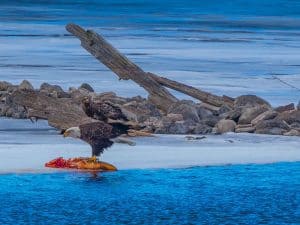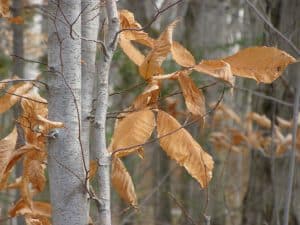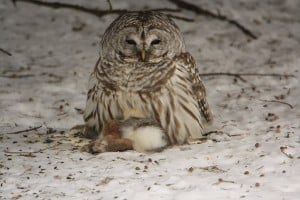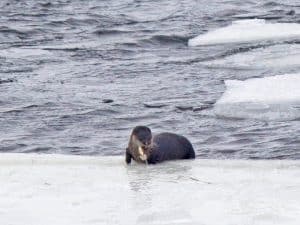Looking back at the fall of 2016, the warming trend that is affecting the entire planet was certainly noticeable in the Kawarthas. While the average temperature for October was only 1 C above normal (compared to the mean temperature for 1971 – 2000), both September and November were nearly 2 C warmer. In fact, 15 of the past 16 months in the Kawarthas have seen above-average temperatures. We need to remember that the Paris Agreement is based on limiting warming to 2 C, since the laws of physics clearly demonstrate that any warming above this threshold will almost certainly result in massive negative impacts to civilization as we know it. However, on a day-to-day basis, we experience this warming in only subtle ways and often welcome the milder temperatures. It is therefore difficult to fully comprehend and ‘feel’ the enormity of what’s occurring and harder still to support forceful action – like sufficiently aggressive carbon taxes – to mitigate the warming. The human brain has simply not evolved to react effectively to slow-motion phenomena like a changing climate.
Although it’s hard to know what kind of weather the coming months has in store for us, the nature events listed below are typical of an average winter in the Kawarthas.
DECEMBER
· December 21 marks the winter solstice, the shortest day of the year and the first official day of winter. The sun rises at its southernmost point on the eastern horizon, and sets at its southernmost point in the west. Sunrise is not until 7:46 a.m. while sunset is already upon us by 4:37 p.m. This translates into a mere 8 hours and 51 minutes of daylight. The winter solstice was celebrated by ancient cultures throughout the northern hemisphere and, in the opinion of some, was a precursor to faith. Try to imagine how an early human would experience the solstice and the weeks leading up to it. In late fall, the hours of daylight are only half of what they are in June, and the Sun is rising and setting further south each day. At a time pre-dating modern science, it would have seemed that the Sun was on the brink of vanishing completely and utter darkness and oblivion would follow. However, the decrease in daylight suddenly stops! Instead of rising and setting further and further south, the Sun abruptly halts its southward march and appears to “stand still ” – the meaning of the word solstice – before proceeding to rise and set further north and to climb higher in the sky. If anything was worthy of celebration, this certainly was.
· Cassiopeia looms like a towering letter “M” in the north sky in the evening. The Inuit imagined the shape of this constellation as stairs sculpted in the snow.
· Overwintering ducks, along with deer carcasses, are an important source of food for bald eagles that spend the winter in the Kawarthas. Watch for them along the Otonabee River and in the vicinity of Jack, Katchewanooka, Buckhorn, and Stony Lakes. Eagles are sometimes seen sitting on the ice beside open water, perched in nearby trees, or soaring overhead.
· Robins should be quite plentiful this winter. The fruits that constitute the robin’s winter diet – mountain-ash, buckthorn, and especially wild grape – are abundant.
· At most city feeders, the number and variety of birds have decreased since the heady days of October. White-throated and white-crowned sparrows, along with most of our blue jays, are now on their wintering grounds in the southern U.S. Although a few scattered flocks of pine grosbeaks have shown up in recent weeks, there is no indication yet of a major incursion of finches such as redpolls or pine siskins.
· Take a drive along River Road north to Lakefield to look for ducks such as goldeneyes and mergansers. Little Lake in Peterborough is also worth checking. A red-throated loon has been there since late November.
· With Christmas wreaths and planters everywhere, December is a great month to learn to identify our native conifers. Here are three simple memory aids that link the sound of letters in the trees’ name to its characteristics : pine needles are long like ‘pins’; spruce needles ‘spiral’ around the twig and are ‘spiky’; while fir needles are ‘flat’ and very ‘flexible’.
· Christmas Bird Counts take place across North America this month. The Peterborough count will be held on December 18, while the Petroglyphs count is slated for December 27. A special Christmas Bird Count for kids will take place at Kawartha Highlands Provincial Park on December 17. It will be a morning of birding, campfires and hot chocolate! To register, please email shannon.mcgaffey@ontario.ca
· Scattered twigs on the ground below conifers are a sure sign of red squirrel activity. The squirrels are after the buds and cones on the twigs.
JANUARY
· Watch for ruffed grouse perched high in trees at dawn and dusk. The birds often appear in silhouette as they feed on buds such as those of trembling aspen.
· Winter is a good time to make plans for additions to your gardens. If you’re interested in attracting more bees and butterflies, you may wish to pick up a copy of the 2017 Peterborough Pollinators Calendar – A 12-Month Guide to Pollinator Gardens and Backyard Nature. The calendars are available at Avant-Garden Shop, Hunter Street Books, Peterborough GreenUp, Chapters and Happenstance in Lakefield.
· The Peterborough Field Naturalist’s 76th Annual General Meeting takes place on January 20. Leora Burman will speak on ‘The Land Between’. Contact Jim Young at 705-760-9397 for tickets. You will also find more information at peterboroughnature.org
· Coyotes are quite vocal during their January to March mating season.
· On January 25, Marcy Adzich will speak at the Peterborough Horticultural Society on “Edible Urban Ecology: Food Forests and Beekeeping in our Urban Community” For more information, visit peterboroughhort.com
· If you’re walking in the woods, you’ll notice that some of the trees have retained many of their leaves. These are usually beech, oak, or ironwood.
· Barred owls sometimes show up in rural backyards and prey on feeder birds or mice and voles that attracted at night by fallen seeds.
FEBRUARY
· Groundhog Day, February 2, marks the mid-point of winter. In case you were wondering, no animal or plant behaviour can portend upcoming weather beyond a few hours.
· On February 8, Basil Conlin will speak to the Peterborough Field Naturalists on mothing in Peterborough. To date, he has found an amazing 560 species. More information at peterboroughnature.org
· Although tentative at first, bird song returns in February as pair bonds are established or renewed. Black-capped chickadees, northern cardinals, and white-breasted nuthatches are usually the first species to start singing this month.
· Gray squirrels mate in January or February and can often be seen streaming by in treetop chases as a group of males chases a half-terrorized female.
· The Great Backyard Bird Count takes place February 17-20. This citizen science event engages bird watchers of all levels of expertise to create a real-time snapshot of the whereabouts and relative abundance of birds in mid-winter. Anyone can participate. Go to birdcount.org for details.
· Watch for river otters in winter around areas of flowing water. Their trough-like, snow-slide trails are often seen on embankments or even flat ground.
· Late February is courtship time for ravens. Males engage in aerial nuptial displays, diving and twisting like corkscrews over Canadian Shield country.
· On mild, sunny, late winter days, check the snow along the edge of woodland trails for snow fleas. What looks like spilled pepper may begin to jump around right before your eyes!
· Testosterone-charged male skunks roll out of their dens any time from mid-February to early March and go on nocturnal prowls looking for females. The smell of a skunk on a damp, late winter night is a time-honoured sign of “pre-spring.”
· By month’s end, spring has sprung for overwintering monarchs in the mountains of Mexico. As lengthening days trigger the final development of the butterflies’ reproductive system, male monarchs begin zealously courting females. In December, the Committee on the Status of Endangered Wildlife in Canada recommended that the monarch be listed by the federal government as Endangered.
EARLY MARCH
· Duck numbers increase as buffleheads and hooded mergansers start arriving.
· Chipmunks make their first appearance above ground since late fall. They did remain somewhat active all winter, however, making repeated trips to their underground storehouses for food.
· On March 8, Peter Mills will speak to the Peterborough Field Naturalists on the larval life of frogs, toads and salamanders. He is the author of “Metamorphosis”. More info at peterboroughnature.org
· The furry catkins of pussy willows and aspens poke through bud scales and become a time-honoured sign of spring’s imminent arrival.
· The first songbirds, too, usually return by mid-month. In the city, the most notable new arrivals are robins and grackles. In rural areas, watch for red-winged blackbirds perched high in wetland trees.



